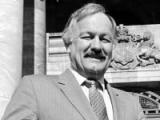What happened that day?
See historic events for any day of the year by entering the date below. Why not try your birthday?
Kiwi of the Week
Today in History

1986 Goods and Service Tax Act comes into force
Initially adding 10% to the cost of most goods and services, GST was a key part of the economic reforms of the fourth Labour government that were dubbed ‘Rogernomics’. Minister of Finance Roger Douglas had the opportunity to implement his ‘new right’ reforms after Labour won a landslide victory in the snap election of July 1984.
The new government inherited an alarmingly high budget deficit and overseas debt, an inflated dollar, and rocketing inflation. The economy was in crisis, and Rogernomics was a ready-made solution – or so it seemed to many.
It was the days of Ronald Reagan and Margaret Thatcher, and ‘new right’ policies were the latest craze worldwide. But nowhere else were they implemented with the speed and zeal shown by Douglas and his supporters. New Zealand was quickly reinvented as one of the most free-market economies in the industrialised world. The agenda came thick and fast: deregulation, privatisation, state asset sales, and the removal of subsidies, tariffs, tax breaks and price controls.
GST was added to the mix in 1986. Opponents called it a ‘regressive’ tax – one that hits the poorest the hardest – because people on low incomes tend to spend the greatest proportion of their money on goods and services.
The reforms had come as a surprise to the electorate and the media. A long period of zero or negative growth increased public concern, and tens of thousands of people lost their jobs. Worried that things had gone too far, Prime Minister David Lange put the brakes on after winning re-election in 1987, calling for a ‘pause and a cup of tea’. Lange forced Roger Douglas to resign from Cabinet in 1988, but he was voted back in by the Labour caucus the following year. Lange himself resigned shortly afterward.
GST was increased to 12.5% in 1989 and remained at that level until 2010 when it was raised to 15%. There is disagreement to this day about whether the reforms were a failed experiment or a necessary step towards a stronger future economy.
Image: Roger Douglas on steps of Parliament (Timeframes)














